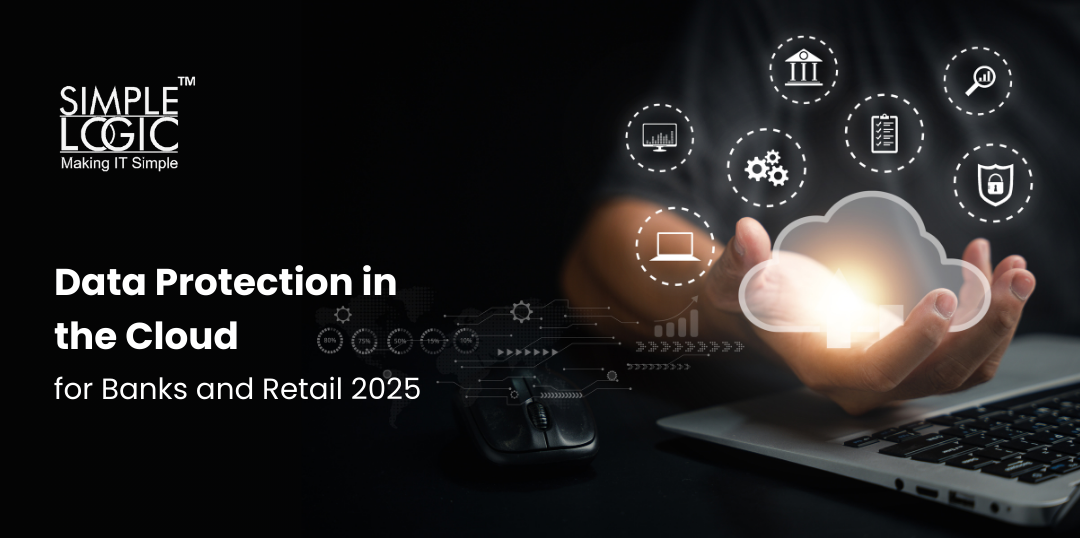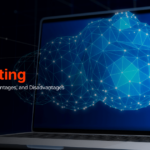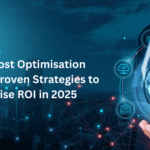Key Takeaways
- Banks and retail companies face rising cybersecurity risks as cloud adoption increases.
- Regulatory compliance, customer trust, and data integrity are critical in 2025.
- Encryption, multi-factor authentication, Zero Trust architecture, and AI-driven monitoring are essential strategies.
- Simple Logic IT offers tailored cloud security solutions and compliance support for banks and retail companies.
- A proactive, future-proof approach to cloud data protection ensures secure growth, operational efficiency, and customer confidence.
Table of Contents
- Introduction
- Why is cloud data protection growing in importance in 2025?
- What are the Core Principles of Modern Cloud Data Protection
- What are the challenges faced by banks and retail companies?
- What are the key risks and implications of cloud data threats?
- What regulatory compliance and standards should be considered in 2025?
- Building a Resilient Architecture for Cloud Data Protection
- What is the operating model needed for success?
- What is the phased implementation roadmap?
- How do you measure success in cloud data protection?
- What are the common pitfalls and how can you avoid them?
- How does Simple Logic IT support banks and retail?
- What sets Simple Logic IT apart from others?
- What are future trends in cloud data protection?
- Conclusion
- Frequently Asked Questions
Worried about how secure your customer’s data is in the cloud? This is a question many banks and retail companies are asking as they move more operations online. With data breaches, fraud, and regulatory fines making headlines every week, protecting sensitive information has become one of the biggest challenges of 2025.
Data Protection in the Cloud for Banks and Retail 2025 is no longer just about compliance—it’s about staying ahead of threats, building customer trust, and running your business smoothly. As cyber risks grow and regulations get stricter, a solid cloud security strategy is essential to keep operations safe and data protected.
In this blog, we’ll explore the common risks, best practices, and future trends in cloud data protection. You’ll also see how Simple Logic IT’s tailored solutions can help you secure your cloud environment and confidently manage compliance—so you can focus on what matters most: growing your business.
Why is cloud data protection growing in importance in 2025?
Cloud computing offers unmatched scalability, operational flexibility, and cost-efficiency. However, these benefits come with heightened risks. For banks, the cloud hosts critical financial transactions, customer account data, and regulatory reports. Retailers, on the other hand, manage vast amounts of customer personal information, payment data, and e-commerce analytics.
Key reasons cloud data protection is crucial in 2025 include:
- Increased frequency and sophistication of cyberattacks.
- Expansion of cloud adoption across multiple platforms and geographies.
- Regulatory expectations for secure and auditable cloud operations.
- Customer demand for privacy, trust, and secure digital experiences.
What are the Core Principles of Modern Cloud Data Protection
Cloud data protection needs multiple layers—it must be measurable, proactive, and aligned with business goals. These principles are essential for banks and retail in 2025.
Data Encryption and Key Management:
Encrypt data at rest and in transit using TLS 1.2/1.3 and AES-256. Use KMS with HSM-backed key management for secure access and regular key rotation. Apply tokenization for payment data to limit exposure of sensitive information.
Identity and Access Controls:
Centralize authentication through a trusted identity provider. Enforce multi-factor authentication (MFA) for all users, especially those with privileged access. Use role-based (RBAC) or attribute-based (ABAC) access controls to restrict permissions. Implement temporary credentials and just-in-time access to reduce risks.
Monitoring, Observability and AI Detection:
Collect logs, metrics, and traces from all cloud environments for visibility. Use AI-driven platforms like AIOps and SIEM to detect real threats and reduce false alerts. Respond quickly to incidents before they escalate.
Immutable Backups and Recovery Planning:
Store backups in immutable formats that cannot be altered or deleted. Ensure geo-redundant storage with strict access controls. Regularly test restore procedures to meet Recovery Time Objectives (RTO) and Recovery Point Objectives (RPO).
Privacy by Design and Data Minimization:
Classify data at the point of collection and only gather what’s necessary. Use data masking, pseudonymization, and differential privacy to protect customer information while maintaining usability.
Policy as Code and Automation:
Define security policies as code within development and deployment processes. Automate policy enforcement for continuous compliance and audit-ready documentation. Make security management easier and more efficient with automated controls.
What are the challenges faced by banks and retail companies?
What cybersecurity threats do they face?
Banks and retail companies face a range of threats including:
- Ransomware attacks: Threat actors encrypt critical data to demand payment.
- Phishing and social engineering: Employees are often targeted to access sensitive data.
- Insider threats: Malicious or negligent internal actors can compromise cloud environments.
- Misconfigured cloud systems: Human error in cloud setup leads to vulnerabilities.
Common Cloud Security Threats and Implications
Since HTML tables don’t format well in plain text, I’ve converted this to a list format that maintains the information:
- Ransomware: Data inaccessible, downtime – Bank transaction system locked
- Phishing: Credential theft, unauthorized access – Retail POS system breach
- Insider Threats: Data leaks, compliance violations – Employee accessing customer data
- Misconfiguration: Public data exposure – Cloud storage containing sensitive info
What regulatory compliance requirements must they meet?
Banks and retail companies must comply with a multitude of regulations:
- Banks: PCI DSS, GDPR, RBI guidelines, FFIEC standards.
- Retail: PCI DSS, GDPR, and local data privacy laws.
Non-compliance risks include hefty fines, reputational damage, and operational restrictions.
What are the key risks and implications of cloud data threats?
Financial Fraud and Data Breach:
Banks process millions of transactions daily. Any cloud data compromise can result in financial loss, legal action, and regulatory penalties. Retailers handle large volumes of credit card and personal data, making them prime targets for fraud.
Insider Threats:
Employees with privileged access can unintentionally or maliciously expose sensitive data. Continuous monitoring, audit trails, and access restrictions are critical.
Customer Trust and Reputation:
A single breach can erode customer confidence. Banks and retail companies rely on trust; protecting cloud data is directly tied to brand reputation.
What regulatory compliance and standards should be considered in 2025?
Banking Regulations:
Banks must adhere to PCI DSS, GDPR, RBI, and FFIEC standards. Cloud security frameworks help ensure secure storage of customer financial data, audit readiness, and continuous compliance monitoring.
Retail Compliance:
Retailers must focus on payment card data protection, customer consent management under GDPR or local privacy laws, and minimising exposure to data breaches.
Global and Regional Standards:
Organisations operating across borders must navigate a combination of international and local regulations to avoid penalties and ensure secure operations.
Building a Resilient Architecture for Cloud Data Protection
A practical and vendor-neutral cloud data protection strategy depends on layered controls that work together to secure your environment. Each layer addresses specific risks while complementing the others to create a robust and adaptive defence system. Below is a structured approach to designing resilient cloud architectures that safeguard data, ensure compliance, and support business continuity.
| Layer | Purpose | Key Controls / Tools |
|---|---|---|
| Edge/API Layer | Control ingress and egress | WAF, API Gateways, Rate Limiting, Schema Validation |
| Identity & Access | Authenticate and authorise | Centralised IdP, MFA, RBAC/ABAC, Just-in-Time Access |
| Data Protection | Encrypt and tokenize data | Cloud KMS/HSM, Application-Level Encryption, Tokenization |
| Observability | Detect and investigate | Central Logging, SIEM, AIOps, Distributed Tracing |
| Backup & Recovery | Ensure business continuity | Immutable, Geo-Redundant Backups, Documented DR Playbooks |
| Governance | Enforce policy and compliance | Policy-as-Code, Continuous Compliance Scans, Audit Trails |
| Automation | Respond at scale | SOAR, Event-Driven Runbooks, Approval Gates |
Why Layered Controls Matter
Each layer plays a vital role in strengthening your cloud data protection:
The Edge/API Layer helps prevent unauthorised access and shields applications from external threats.
Identity & Access controls ensure only verified users can interact with sensitive data.
Data Protection mechanisms encrypt information at rest and in transit to prevent breaches.
Observability provides continuous monitoring to detect suspicious activities early.
Backup & Recovery guarantees that you can restore services in case of failure or disaster.
Governance ensures compliance with policies and regulations while offering traceability.
Automation enables rapid and consistent responses to threats without manual intervention.
Together, these controls create a resilient, scalable, and secure cloud environment that supports modern workloads while minimising risk.
What is the operating model needed for success?
From Periodic Audits to Continuous Assurance:
Shift left—link compliance controls to telemetry signals and automated policy checks. Embed pipelines that continuously scan for drift, remediate issues, and generate immutable evidence logs.
The Operating Model: People, Processes, and SLOs:
Define Service Level Objectives (SLOs) for availability, Mean Time to Repair (MTTR), and evidence collection. Roles must be clear: Business Owners determine risk appetite, Security Teams set policies, Platform Engineers build secure foundations, and SOC Teams monitor and respond. Core processes include automated entitlement reviews, change controls with embedded policies, and regular disaster recovery drills.
What is the phased implementation roadmap?
Phase 1: Discover & Classify (0–30 Days):
Identify crown-jewel data and services. Run automated scans to highlight sensitive data and misconfigurations. Create a risk heatmap.
Phase 2: Baseline & Remediate (30–90 Days):
Implement quick wins: enforce MFA for all admins, fix exposed storage, centralise logs, and move encryption keys to a managed KMS/HSM.
Phase 3: Observe & Automate (90–180 Days):
Deploy AIOps and SIEM for priority use cases. Start with low-risk automation like token revocation and quarantining resources, with human approval gates.
Phase 4: Harden & Scale (6–12 Months):
Introduce policy-as-code. Expand automation to medium-risk tasks. Conduct full disaster recovery drills and validate against SLOs.
Phase 5: Optimize & Operate (12+ Months):
Tune models and playbooks continuously. Report on outcomes like reliability, cost, and risk.
How do you measure success in cloud data protection?
Frame your security investment around tangible business benefits: Reduced Downtime, Lower Audit Costs, Operational Efficiency, and Risk Reduction.
Sample KPI Dashboard:
- MTTR for Data Incidents
- % of Critical Misconfigurations Remediated within SLA
- Backup Restore Success Rate
- Audit Evidence Completeness %
What are the common pitfalls and how can you avoid them?
Tool Sprawl:
Multiple point solutions create noise, not insight. Mitigation: Start with a unified observability strategy.
Automating Chaos:
Automating noisy alerts causes more problems. Mitigation: Stabilise alerts first. Begin with human-in-the-loop automation.
No Governance for Automation:
Automation without RBAC/approval gates is risky. Mitigation: Implement policy-as-code and version-controlled runbooks.
Treating Compliance as a Project:
Auditors demand continuous proof. Mitigation: Build evidence collection into daily operations.
How does Simple Logic IT support banks and retail?
Simple Logic IT provides end-to-end cloud data protection solutions specifically designed for banks and retail companies. Services include:
- Managed Cloud Security Services: Continuous monitoring, threat detection, incident response, and security patching.
- Compliance Assistance: Guidance and auditing support for PCI DSS, GDPR, RBI, and other standards.
- Risk Assessment & Monitoring: Tailored risk assessments, vulnerability scans, penetration testing, and AI-driven analytics.
- Cloud Migration & Data Protection Solutions: Secure migration with encryption and tokenisation, and post-migration monitoring
What sets Simple Logic IT apart from others?
- Outcome-First: We start with your SLOs and work backwards.
- Audit-Ready Automation: Every action is versioned, approved, and logged for a transparent audit trail.
- Talent Transfer: We empower teams with knowledge to avoid vendor lock-in.
What are future trends in cloud data protection?
Multi-Cloud and Hybrid Strategies:
Using multiple providers for redundancy and flexibility to distribute sensitive workloads and reduce risk.
Automation and AI-Driven Security:
Evolution of AI for faster, more accurate threat detection and automated incident response.
Predictive Analytics:
Using historical and behavioural data to predict potential breaches and enable proactive risk management.
Conclusion
Securing cloud data for banks and retail in 2025 isn’t just about ticking compliance boxes—it’s about building trust, safeguarding operations, and staying one step ahead of threats. As cyber risks evolve and customer expectations rise, organisations must embrace a proactive and layered approach to cloud security.
With the right strategies in place, your business can confidently scale while keeping data protected. Simple Logic IT is here to help you every step of the way—from risk assessment to secure cloud migration—so you can focus on growing your business with peace of mind.
Ready to strengthen your cloud security posture and build customer trust? Get in touch with Simple Logic IT today and make cloud protection a priority for 2025 and beyond.
Frequently Asked Questions
1. What is cloud data protection?
Cloud data protection secures sensitive data in cloud environments using encryption, access controls, and compliance frameworks.
2. Why is cloud data protection important for banks and retail?
It prevents data breaches, ensures regulatory compliance, and builds customer trust while supporting business continuity.
3. What are the best practices for cloud data protection?
Encrypt data, enforce MFA and role-based access, monitor for threats, use immutable backups, and minimize data collection.
4. How does cloud data protection support compliance?
It aligns security controls with regulations, enabling audit trails, encryption standards, and secure data handling.
5. How can Simple Logic IT help with cloud data protection?
We offer managed security services, compliance support, risk assessments, and secure migration planning.




